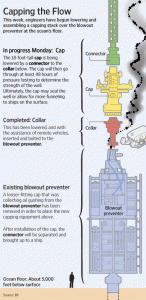Let’s hope that the new cap proves the well is solid and intact.
If it proves that the well when capped is forcing the oil out of other parts of the broken BOP or into the seabed (below the seafloor) we have new things to consider.
Of note is a decision by the engineers to plug off the last 2,000 feet of the then 13,000 foot hole with cement and continue in a new direction. Does this old “2,000 foot” pose a problem? Will the relief well be able to account for this?
Here is the detail of what happened on March 8, 2010 from the WSJ:
[W]orkers discovered that gas was seeping into the well, according to drilling reports from the rig reviewed by the Journal. Workers lowered a measuring device to determine what was happening, but when they tried to pull it back up, it wouldn’t budge. Engineers eventually told them to plug the last 2,000 feet of the then-13,000-foot hole with cement and continue the well by drilling off in a different direction.
The episode took days to resolve, according to drilling reports, not counting time lost to backtracking and re-drilling. Each additional day cost BP $1 million in rig lease and contractor fees.
Another scary note from the WJS.com article:
The rock was so brittle in places that drilling mud cracked it open and escaped. One person familiar with the matter estimates BP lost at least $15 million worth of the fluid.


Pingback: Relief Wells | Freeze Oil